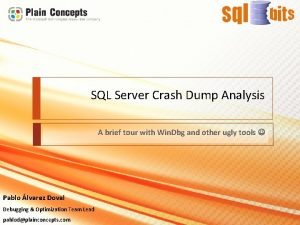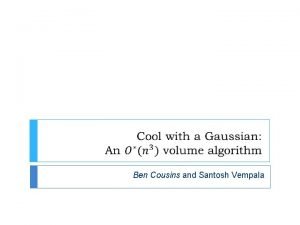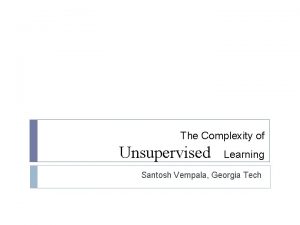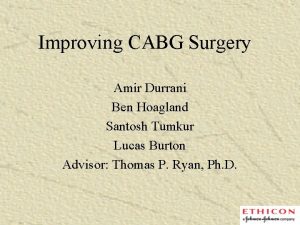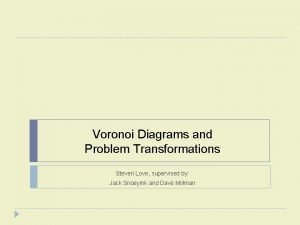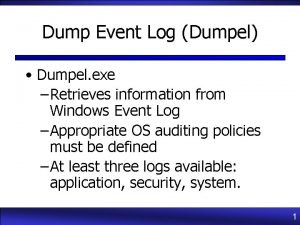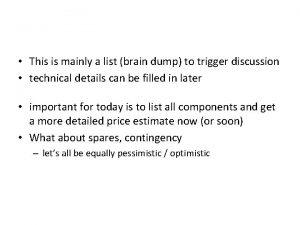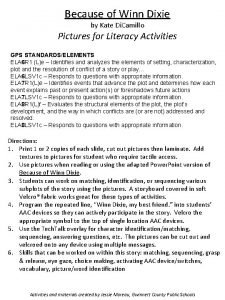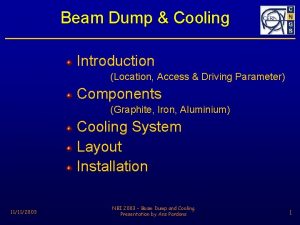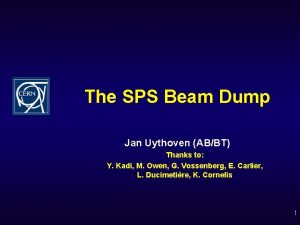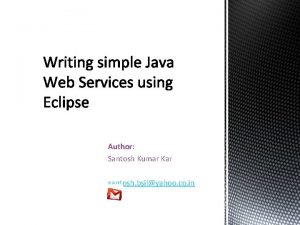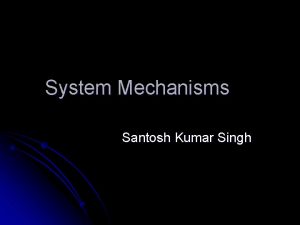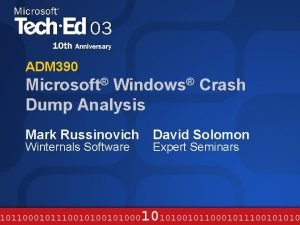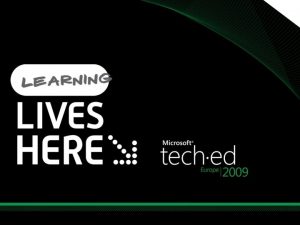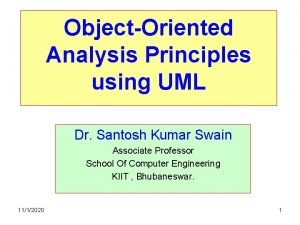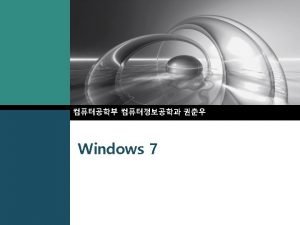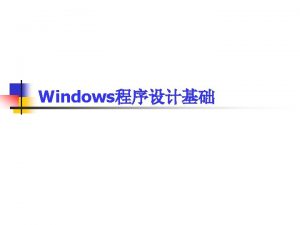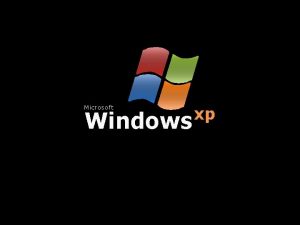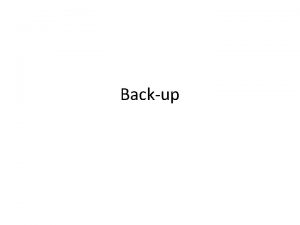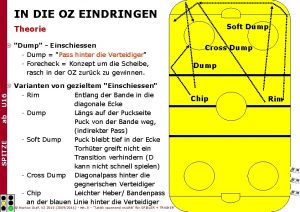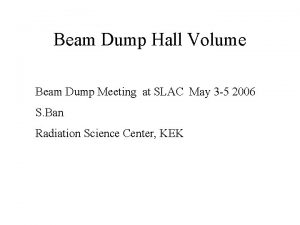Crash Dump Analysis Santosh Kumar Singh Windows Crash





















- Slides: 21

Crash Dump Analysis - Santosh Kumar Singh

Windows Crash The “blue screen of death. ” n Occurs when windows crashes, or stops executing, because of a catastrophic fault or an internal condition that prevents the system from continuing to run n

Why windows crash n n A device driver or an operating system function running in kernel mode incurs an unhandled exception, such as a memory access violation. A call to a kernel support routine results in a reschedule, such as waiting for an unsignaled dispatcher object when the interrupt request level (IRQL) is DPC/dispatch level or higher.

Why windows crashes n n A page fault on memory backed by data in a paging file or a memory mapped file occurs at an IRQL of DPC/dispatch level or above A device driver or operating system function explicitly crashes the system (by calling the system function Ke. Bug. Check. Ex) because it detects an internal condition that indicates either a corruption or some other situation that indicates the system can’t continue execution without risking data corruption

Why windows crashes n A hardware error, such as a machine check or a nonmaskable interrupt (NMI), occurs.

The Blue Screen n n Regardless of the reason for a system crash, the function that actually performs the crash is Ke. Bug. Check. Ex. This function takes a stop code (sometimes called a bug check code) and four parameters that are interpreted on a per–stop code basis. After Ke. Bug. Check. Ex masks out all interrupts on all processors of the system, it switches the display into a lowresolution VGA graphics mode (one implemented by all Windows-supported video cards), paints a blue background, and then displays the stop code, followed by some text suggesting what the user can do. Finally, Ke. Bug. Check. Ex calls any registered device driver bug check callbacks (registered by calling the Ke. Register. Bug. Check. Callback function), allowing drivers an opportunity to stop their devices.

The Blue Screen

Possible Recovery F 8 Key for last best configuration. n Uninstalling last installed software. n Drivers that cause problems can be identified and suitable action can be taken. n

Crash Dump Files n n By default, all Windows systems are configured to attempt to record information about the state of the system when the system crashes. Three levels of information can be recorded on a system crash: – Complete memory dump – Kernel memory dump – Small memory dump (Minidump)

Crash Dump Generation When the system boots, it checks the crash dump options configured by reading the registry value HKLMSystemCurrent. Control. SetContr olCrash. Control n Error Reporting n

Crash Dump Generation

Online Crash Analysis n n Dumprep generates an XML-formatted file containing a basic description of the system, including the operating system version, a list of drivers installed on the machine, and the list of Plug and Play drivers loaded on the system at the time of the crash The file and minidump is sent to http: //Watson. Microsoft. Com

Online Crash Analysis n n The analysis generates a bucket ID, which identifies the particular type of crash. It queries the database for more information. If a hot fix or patch is available, a URL is sent that refers to http: //oca. microsoft. com If its not found, an email is sent to the user.

Notmy. Fault n n n You can use the Notmyfault utility from www. sysinternals. com/windowsinternals to generate the crashes described here. Notmyfault consists of an executable named Notmyfault. exe and a driver named Myfault. sys. When you run the Notmyfault executable, it loads the driver and presents the dialog box, which allows you to crash the system in various ways or to cause the driver to leak paged pool.

Notmy. Fault

Using Crash Troubleshooting Tools n n If there are one or more drivers you consider likely sources of the crashes, enable them for verification using the Driver Verifier and check all the verification options except for low resources simulation. Enable the same level of verification as in level 1 on all signed and unsigned drivers in the system.

Buffer overrun Pool corruption usually occurs when a driver suffers from a buffer overrun or buffer underrun bug that causes it to overwrite data past either the end or start of a buffer it has allocated from paged or nonpaged pool. n This is usually hard to debug due to data corruption n

Special Pool

Advanced Crash Dump Analysis n n n Use the !process 0 0 debugger command to look at the processes running and make sure that you understand the purpose of each one. Use the lm command with the kv option to list the loaded kernel-mode drivers Use the !vm command to see whether the system has exhausted virtual memory, paged pool, or nonpaged pool.

Stack Trashes n n Stack overrun or stack trashing results from buffer overrun or underrun bugs. the target buffer is on the stack of the thread that executes the bug. Hung or Unresponsive Systems n A device driver does not return from its interrupt service (ISR) routine or deferred procedure call (DPC) routine n A high priority real-time thread preempts the windowing system driver’s input threads n A deadlock (when two threads or processors hold resources each other wants and neither will yield what they have) occurs in kernel mode

- End of Presentation
 Santosh kumar swain kiit
Santosh kumar swain kiit Sql server crash dump analysis
Sql server crash dump analysis Raj birk
Raj birk Acpion
Acpion Santosh vempala
Santosh vempala Santosh patel life of pi
Santosh patel life of pi Santosh vempala
Santosh vempala Amir durrani
Amir durrani Singh song context
Singh song context Toxic waste dump problem voronoi
Toxic waste dump problem voronoi Tamagotchi 6502
Tamagotchi 6502 Snarget
Snarget Dump event log
Dump event log Spidr4
Spidr4 Maz 700
Maz 700 Dump and clump strategy
Dump and clump strategy Factors affecting haulers productivity
Factors affecting haulers productivity Contoh surat penawaran sewa dump truck
Contoh surat penawaran sewa dump truck Winndixie book
Winndixie book Gloria dump
Gloria dump Dump cooling
Dump cooling Uuu dump
Uuu dump

